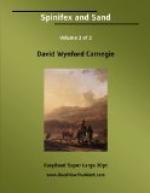CHAPTER VIII
WOODHOUSE LAGOON REVISITED
June 12th, 13th, 14th, we rested at the welcome creek and had time to examine our surroundings. I made the position of our camp to be in lat. 26 degrees 0 minutes, long. 125 degrees 22 minutes, and marked a gum tree near it with C7. Therefore I concluded that this was the Blythe Creek, of Forrest; everything pointed to my conclusion being correct, excepting the failure to find Forrest’s marked tree, and to locate his Sutherland Range. However, the bark might have grown over the marking on the tree—and several trees showed places where bark had been cut out by the natives for coolimans, and subsequently closed again—or the tree might have been burned, or blown down. As to the second, I am convinced that Forrest mistook the butt-ends of the sand-ridges cut off by Lake Breaden for a range of hills, for he only saw them from a distance. The creek heads in a broken sandstone range of tabletops and cliffs; from its head I sighted a peculiar peak, about nine miles distant, which I took to be Forrest’s “Remarkable Peak,” marked on his map. From the sketch that I made, Sir John recognised the peak at once. From the cliffs the sandhills round Lake Breaden look exactly like a range of hills “covered,” as Forrest said, “with spinifex.” Another proof of the non-existence of, at all events, the northern portion of the Sutherland Range, is afforded by Breaden’s experience. As I have already stated, he accompanied Mr. Carr-Boyd on a prospecting trip along this part of Forrest’s Route. From his diary I see that they passed about three miles North of Forrest’s peak, which Breaden identified, though by Mr. Carr-Boyd’s reckoning they should have been twenty miles from it. Travelling due West across the creek on which we were camped, they found a large clay-pan, and were then hourly expecting to cross the Sutherland Range. However, no range was seen, only high sandhills. That Breaden’s reckoning was correct was soon proved, for he and I walked from our camp and six miles West found the big clay-pan and their camel tracks. The lagoon was dry, though they had found it full of water. It is clear, therefore, that the range exists only as sandhills, north of lat. 26 degrees 0 minutes. Numerous other creeks rise in the broken range, and no doubt their waters, after rain, find their way into Lake Breaden.
Our camp was on the longest of them, though others that I followed down were broader. Above our camp, that is to the South-East, a ledge of rock crossed the creek forming a deep little pool which would hold plenty of water. I much regretted being unable to find Forrest’s tree—but a tree unless close to some landmark is not easily come upon—as at its foot he buried a bottle holding letters and his position for that camp.
We saw no more of the natives who had been camped on the creek, but left some articles that should be of great use to them. Everything of weight that was not absolutely necessary was left here, and this included a number of horseshoes.




